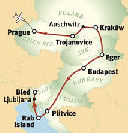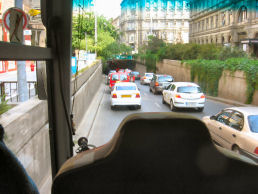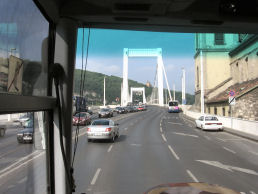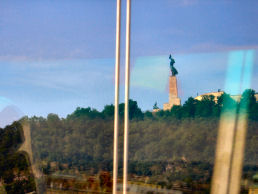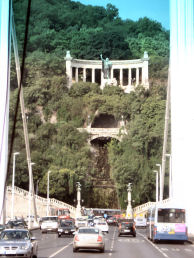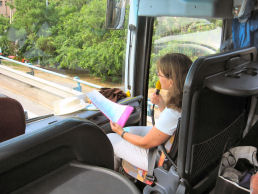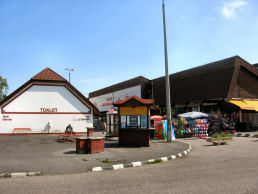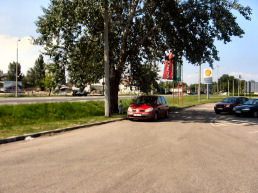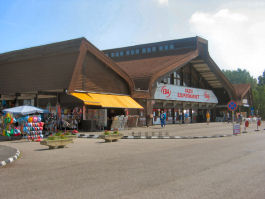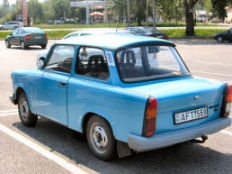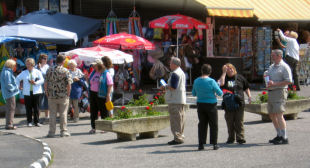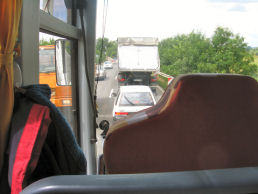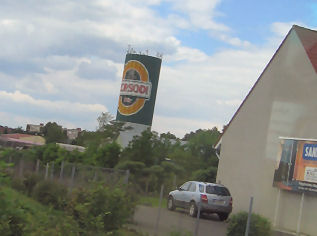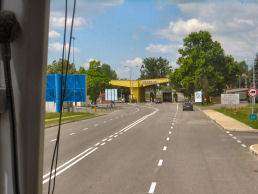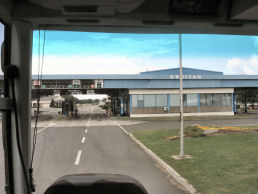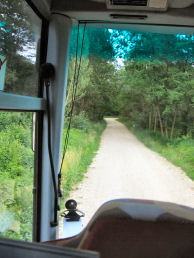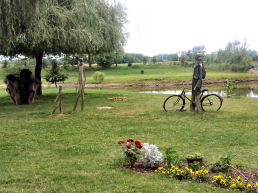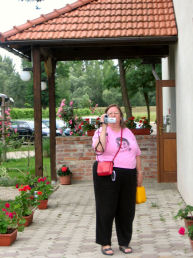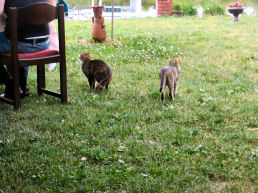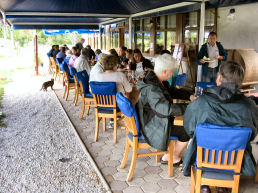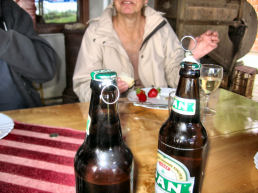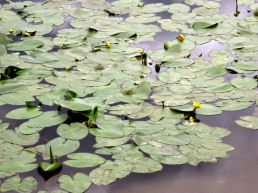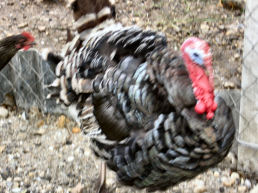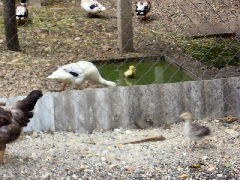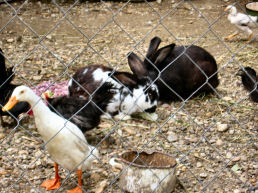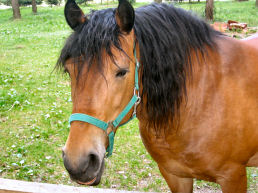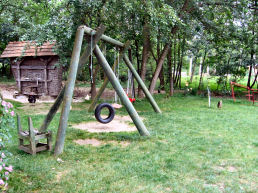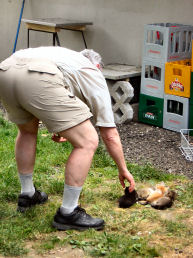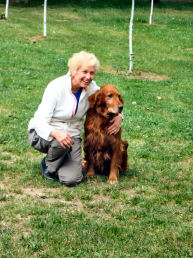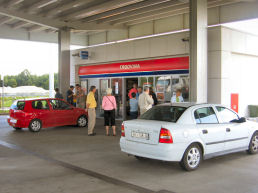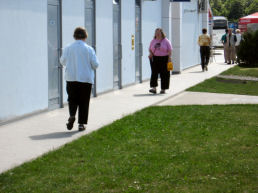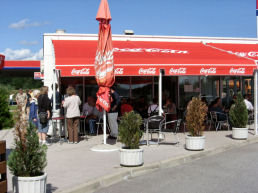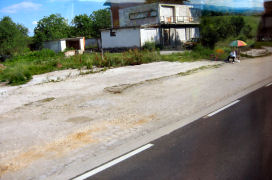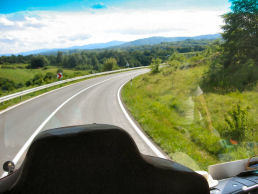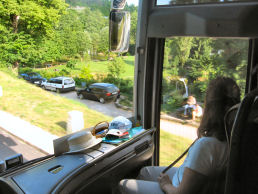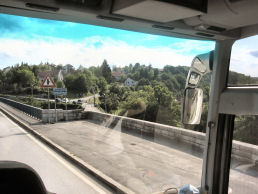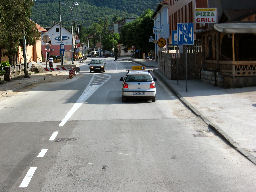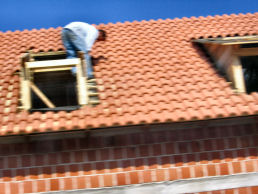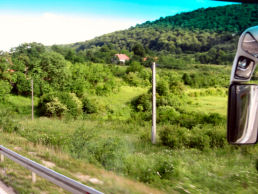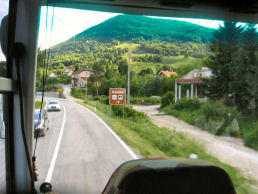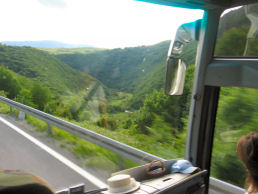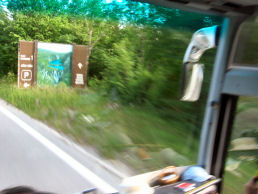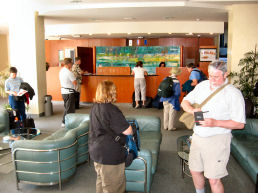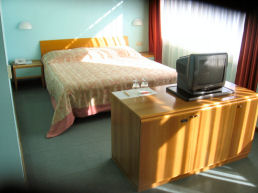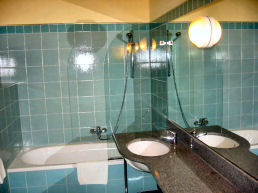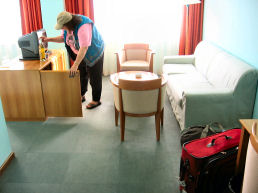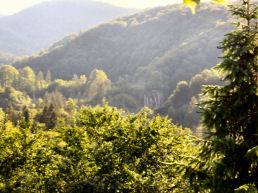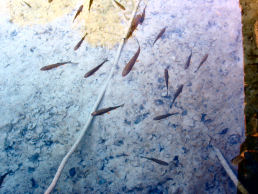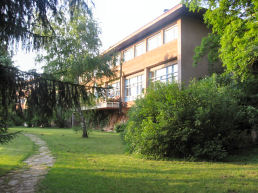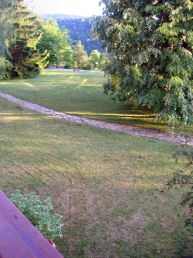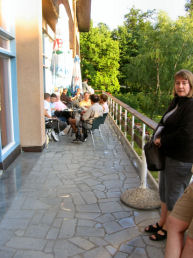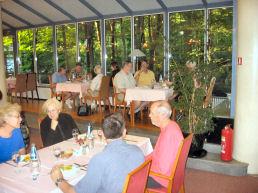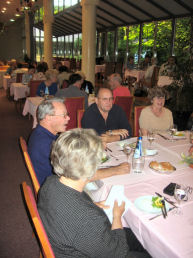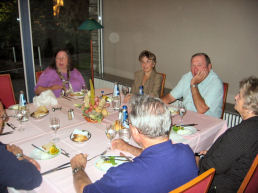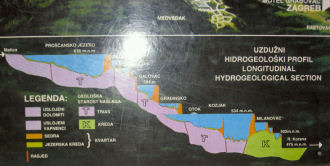I tried to download my e-mail, but the dlink trick did not work as it had the previous day. Oh, well. I did not know when or where (or if) I would be able to get e-mail after Budapest. No more large cities were on our itinerary.
At about seven I went down to breakfast while Sue got herself together. For the second day in a row I neglected to bring my camera down to the restaurant. I met Marge on the elevator. She was evidently not a morning person. Just about the only word that she managed to get out was "coffee." Unfortunately the coffee at this hotel was the worst of the tour. It was strong, which is not necessarily bad, but it was not very hot. The same was true the previous day. It is hard to imagine how they could consistently serve lukewarm coffee even if they wanted to. The water has to be quite hot to dissolve the coffee, doesn't it?
Marge and I joined Nedra and Barbara at their table. They told us about the concert that they had attended the night before. It featured a violinist and a choral group from Houston. The latter sang "Dona nobis pacem" by Raph Vaughn Williams, a work with which I was not familiar. Evidently the orchestra was gigantic. Nedra told me that choral singers are generally responsible for their own expenses when they travel.
I was able to get on to the Internet via wifi after breakfast. I was able to connect when I moved the computer closer to the outside wall. I answered an e-mail from Denise. She sent me the two quotes for Macy’s. I had started them before I left, but she had to finish them. Macy’s must have been giving her a hard time. I could not help wondering what would come of all this in the next week.
The topology of the toilets in this hotel is worthy of a PhD dissertation. Tom speculated that they were designed by someone who had swallowed his wedding ring. Nuff sed.
Sue and I were the last ones on the bus, which was scheduled to depart at 8:30. Susana had to call the room to make sure that Sue was coming. The only empty seat that I could see was right behind Bojan. I would have selected that seat every time if I had had the opportunity. Rather than a pull-down tray, it featured a small table. Unlike the trays, it was large enough to hold my laptop. This meant that I would be able to work on the computer for most if not all of the longest travel day of the entire tour. I decided to leave the computer on rather than risk trying to boot it up again without the electricity. Susana surprised us with the information that Hungary’s government had developed a good relationship with Putin and Russia. My distinct impression was that none of the former satellites wanted anything to do with Russia. Evidently I was wrong. Susana told us about marc, the leftover residue from the fruit that was used for brandy. It was similar in composition to grappa, the only drink that I had ever seen left-over from a Rick Steves tour wine-tasting. The brandy that we had in the initial toast in the wine-tasting in Eger was an example of marc. As far as I can tell, the purpose of these beverages is to speed up the inebriation process. We learned that paprika, which, like everything else, the Hungarians accent on the first syllable, was used for centuries as a substitute for pepper, which was too expensive for common people. It became popular in the rest of Europe in the middle of the nineteenth century. Susana said that it was pretty much only grown in Hungary. Paprika is a good source of vitamin C and vitamin A. Many scientists and inventors have come from Hungary. One Hungarian scientist won the Nobel prize by synthesizing vitamin C.According to Susana Hungarians have a lower life expectancy than the rest of Europe. They have accepted waste from the western countries. I was not sure whether these two facts were related.
The Hungarians call their great plain the Puszta. The Hungarians have produced lots of music over the years. Flat lines, wooden wells, and dancing are also associated with Hungary.
Susana reported that some people from Germany travel to Hungary to get dental work done. The Hungarian dentists are quite skilled, and their prices are much lower than in "old Europe." We stopped for a toilet break at the Oazis Szupermarket. Everyone else used up the rest of their forints at the large store, but I barely had enough to cover the eighty forint for use of the toilet. The fourteen that I had left over I gave to Sue. She told me that she paid for Joan’s use of the toilet. The way that she put it was, "Joan owes me a pee." Neither Sue nor I had even a single forint left over.I spent the rest of the break walking around the parking lot taking photographs. To my astonishment a Trabi was parked in the lot. It looked just like the one at the Statue Park. I also discovered by chance that the store had generously provided an alternative toilet for those who could not afford the cost of the standard one. A kid was using it. His father parked the car so as to block the view of the people in the supermarket. He almost certainly did not anticipate a Yankee with time on his hands, a digital camera with a zoom lens, and six fully charged batteries.
After the break we drove near Lake Balaton, the largest lake in Hungary. Susana told us that the most common trees in this part of the country were acacia and linden trees. Susana said that one of the bridges that traversed over the road was actually a cattle crossing. In fact, we saw a couple of them. At some point I dozed off. I woke up when we came to a traffic jam. My passport, which I had placed on the table in front of me, was missing. It must have fallen off while I was sleeping. Since we were rapidly approaching the Croatian border, this could have been serious. Fortunately, Andy, who was seated behind me, retrieved it from under my seat. I was a little surprised to learn that Croatia was not part of the European Union. So Hungary’s southern border was actually the E.U.’s frontier. When we came to the border, we pulled into the bus lane, but no one paid any attention to us. We had plenty of time to examine the surroundings from the bus. The buildings were made of yellow stucco. In several of the corners swallows had built nests. We saw them flitting about. I was sitting almost across from Susana, so I was able to note that she traveled on a Swiss passport. The Hungarian border guards made us sit in the sun for some reason. Bojan popped the sun roofs open. It took a little over thirty minutes to get through the Hungarian side of the border. To get to the Croatian border station we crossed a bridge over a muddy little stream with a half-submerged tree in it. A very friendly representative of the Croatian Policija came onto the bus and stamped our passports. Susana had taught us to say thanks in Croatia, “Hvala.” Then Bojan had to go through some kind of monkey business with a guy in a light blue suit. When the Croatian border guard left the bus, I called out, “Do viđenjia.” He smiled and said “Bye-bye.” Susana then ran in to use the Bankomat so that she would be able to pay for our lunch. We stopped at a small place just inside the Croatian border called Zelengaj. We had a nice buffet of sandwich stuff and fruit, including fresh strawberries. Dessert was a cornbread with some kind of an icing that included nuts. Tom and I drank a mediocre beer called Pan. It was brewed in Croatia by Carlsberg. Its main point of interest was the flip top bottles in which it was served.
The Croatians had a lot of experience at tourism. Except for the periods in which the country had been at war with Serbia, it has been a hot destination for Europeans almost since the end of World War II. It was therefore hard to understand the approach used by this restaurant. It was easily able to provide for our entire group with the tables outside, and there were approximately twice as many more tables inside. However, the small sign on the highway that indicated that the restaurant was down the unlikely-looking dirt road was visible from only one direction. Could the restaurant ever be filled?
One possible explanation was that the restaurant was really just a sideline. First and foremost the place was obviously a farm. The high point of the lunch for me was visiting all of the animals - a horse, a dog, some cats (including a fresh litter), turkeys, chickens, ducks, geese, and rabbits. I heard but did not see a rooster.
The low point for me was when I stepped off the edge of the sidewalk, fell on my face, and twisted my left ankle. Janet very nicely asked me if I was all right. She also asked me if my camera was OK. Up until then it had not occurred to me that an electronic device might react badly to being slammed into the ground. I put it through its paces, and it seemed to be all right.
I realized immediately that I had picked the worst possible moment to pull this stunt. I knew very well that there was nothing to do in Plitvice National Park except hiking. I had done enough research to know that it was one of the true natural wonders of the world. This would probably be a once-in-a-lifetime chance to see it. I expected that the ankle would probably feel worse on the next day. Maybe I could wrap it in a sock or something.
I limped back to Bojan’s bus, where I learned that it had two horns. One sounded like a regular horn. The other one impersonated a Slovenian cow. He tried it out, but the Croatian cows did not seem to understand the horn’s accent. Croatia seemed to be a place of contradictions. I was very impressed with the modern state of the highways and many of the facilities. On the other hand we saw people cultivating fields by hand with hoes. Susana later explained that many of these people were ethnic Serbs who had refused to abandon their lands during the last war in 1995. They just were able to scrape by with subsistence agriculture. Not very long after we entered Croatia it became quite hilly. Susana explained that one of Croatia’s most dominant features are the Dinaric Alps, which extend from the Julian Alps down the Adriatic coast. . According to Susana Croatia’s early history was non-descript. The Romans captured and ruled the area for a long period of time. In order to protect themselves from various raiders, the Croatians eventually allied with Hungary. However, over the centuries the Hungarians took over more and more of their territory. The Venetians came to rule the area along the Adriatic coast. The Turks conquered the entire country in the 14th Century. They were not completely driven out until the Hapsburgs reclaimed the territory in the nineteenth century. Yugoslavia came into existence after World War I. During the twenties and thirties the area was ruled by a Serbian King. The Croats, who have always been Roman Catholics, looked to the Nazis for help in liberating themselves from the Greek Orthodox Serbs. The Nazis installed the Ustaše in power, and this group brutally murdered hundreds of thousands of Serbs and Jews.The Austrians had settled many ethnic Serbs in southern Croatia in the region known as Vojna Krajina, the very area that we would be visiting. They often were called on to defend the region from the Ottoman Turks right up until the 1800’s.
After World War II Yugoslavia was ruled by Tito. Nominally a Communist, he held the disparate parts of the country together through clever decisions, adept diplomacy, the force of his engaging personality, and occasional brutal repressions. After he died, the country quickly fell apart.
The Croats became more independent from Yugoslavia in the early 1990’s under the nationalistic leadership of Franjo Tuđman, who implemented changes that were reminiscent of the Ustaše, the organization set up by the Nazis in World War II. He incorporated the checkerboard pattern of the Ustaše flag into the Croatian emblem. The Serbs living in Croatia, perhaps influenced by the rhetoric of Serbian president, Slobodan Miloševič, chafed at these changes. In 1991 the Serb-dominated Yugoslav army entered Vojna Krajina in support of the ethnic Serbs residing there. In 1995 the Croats, having purchase arms from the Hungarians, reclaimed Vojna Krajina by force. After a very bloody war and a good deal of ethnic cleansing on both sides the Croats were granted their independence. We saw several buildings in diverse towns in Vojna Krajina that were still riddled with bullet holes. There were also some buildings that had been blown to smithereens. However, for the most part the country appeared to have recovered. At one point a bird flew into the bus’s windshield. Susana said that it bounced off and flew away. Right.Susana told us that the Winnetou movies had been filmed in Plitvice National Park. For some reason the Europeans thought that the American west looked like Plitvice National Park. Winnetou was supposed to be a Mescalero Apache, so the lush settings of Plitvice were totally inappropriate for someone living in the desert southwest. These movies were evidently very popular in all of Europe. Old Shatterhand (most of us in the tour group thought that Susana was saying either "Old Cheddarhead" or "Old Chowderhead"), the cowboy, was played by Lex Barker. Winnetou was played by the French actor, Pierre Brice.
Susana had never gotten over the fact that the Indian maid Nscho-tschi (which sounded to me something like Indochee when Susana said it), with whom she closely identified, was killed by the bad guys in one of the movies. Nscho-tschi was Winnetou’s little sister.The Winnetou stories were written by Karl May, who had never even visited the United States. His stories and the movies are still popular in Europe.
We arrived at the Hotel Plitvice late in the afternoon. It was very nice, much nicer than I had expected. The architecture was from the 1950’s, but it was in immaculate condition. It was also much larger than I expected it to be.Sue and I ported our stuff up a small staircase to room #105. Sue was delighted to find that there was a small refrigerator in the room. She was still carrying around a considerable quantity of foodstuffs. We also had a couch, a television, and a very large bathroom with a tub. As in Budapest, however, there was no shower curtain. Do the people in this neck of the woods take horizontal showers?
I had a flash of inspiration, a moment in which I felt kinship with Thomas Edison. I remembered that the small pouch that Delta Airlines had provided us on the flight from Atlanta to Prague included two socks. I rooted around in my suitcase until I found them. I then took out a safety pin from my sewing kit and made one long stretchy cloth out of the two socks. I wrapped my ankle with my makeshift bandage. It actually seemed to work fairly well.
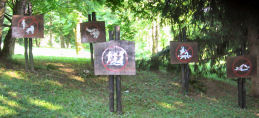
The lake was very nice and peaceful. It had a dock from which you could see a very large number of fish very easily. I was even able to photograph them. We saw several members of the tour group. As we were walking back we ran into Sue and Patti. Then Sue went off on her own to shoot some movies. She might have been filming Winnetou IV.
Nearly everyone hung around the hotel’s very long balcony until it was time for dinner at 7:30. Then we all descended down to the restaurant, which was located a floor, or at least half of a floor, beneath the hotel’s lobby.
At supper I deliberately sat with Marge and Mike, Anne and Paul, and Joan and Ray. I had not talked much with any of these people, and I wanted to get to know everyone in the group as well as possible. I saved a place for Sue, who was very late in arriving. I eventually excused myself to go chase her down. I encountered her on the staircase coming down to the restaurant. The meal stared with a cheesy thing and bread; someone said that it was ricotta. It was the only thing that I could not stomach up to this point. We then had a salad with red cabbage, lettuce, and tomato followed by sausages with pepper sauce, pork and beef on a skewer, rice and pasta mixed, and strudel. As usual, there was certainly plenty of food. The beer, which was a little difficult to obtain, was Karlovačik. I suspected that Paul was a little frustrated by the slowness of the beverage service.
One section of the restaurant seemed to be dedicated to our tour group. We were greatly outnumbered by a group of oriental tourists. The hotel’s dining area was enormous. Even with both groups eating at the same time, there were plenty of empty tables.
I learned after supper that Patti had actually brought an Ace ankle bandage with her, and she was more than willing to loan it to me. My ankle did not hurt much that evening. If I wrapped it pretty tight, I was pretty sure that I would be able to hike the next day without any problem at all. I must say, however, that I was a little disappointed that my own contraption would not be put to the test. I went up to the room, and I soaked in the tub for quite a few minutes. By 9:30 I was in bed and headed for dreamland.